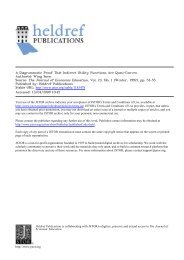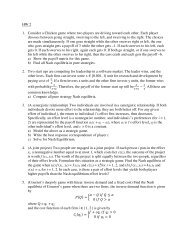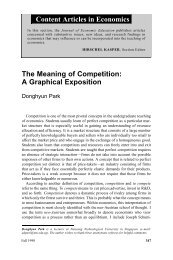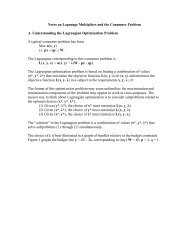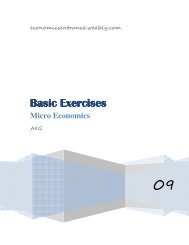Problems
Problems
Problems
You also want an ePaper? Increase the reach of your titles
YUMPU automatically turns print PDFs into web optimized ePapers that Google loves.
<strong>Problems</strong><br />
Tutorial 1: Topics in Microeconomics<br />
Kirori Mal College, University of Delhi<br />
1. Assume the cost of commuting to work for an individual with wage w is wf(n) by car and wx +<br />
t by metro where n is the number of cars on the road, and x and t are constants. Let there be a<br />
total of N commuters. Assume that f(0) = 0 and f’, f” > 0.<br />
(a) Assume everyone makes the same wage. What will be the equilibrium number of drivers?<br />
How will the equilibrium number change with the wage?<br />
(b) What is the socially efficient number of drivers? How does this number change with wage?<br />
2. Suppose that identical duopoly firms have constant marginal costs of Rs. 10 per unit. Firm 1 faces<br />
a demand function q1 = 100 − 2p1 + p2, where q1 is Firm 1’s output, p1 is Firm 1’s price, and p2<br />
is Firm 2’s price. Similarly, the demand Firm 2 faces is q2 = 100 − 2p2 + p1. Solve for the Nash<br />
(Bertrand) equilibrium.<br />
3. Consider the following social problem. A pedestrian is hit by a car and lies injured on the road.<br />
There are n people in the vicinity of the accident. The injured pedestrian requires immediate<br />
medical attention, which will be forthcoming if at least one of the n people calls for help. Simultaneously<br />
and independently, each of the n bystanders decides whether or not to call for help (by<br />
dialing 100 on a cell phone or pay phone). Each bystander obtains v units of utility if someone<br />
(anyone) calls for help. Those who call for help pay a personal cost of c. That is, if person i calls<br />
for help, then he obtains the payoff v − c; if person i does not call but at least one other person<br />
calls, then person i gets v; finally, if none of the n people calls for help, then person i obtains zero.<br />
Assume v > c. Find the symmetric mixed strategy Nash equilibrium of this n-player normal-form<br />
game. Compute the probability that at least one person calls for help in equilibrium. Note how<br />
this depends on n.<br />
4. The famous British spy 001 has to choose one of four routes, a, b, c, or d (listed in order of speed in<br />
good conditions) to ski down a mountain. Fast routes are more likely to be struck by an avalanche.<br />
At the same time, the notorious rival spy 002 has to choose whether to use(y) or not to use(x) his<br />
valuable explosive device to cause an avalanche. The payoffs of this game are represented here:<br />
002→ x y<br />
001↓<br />
a 12,0 0,6<br />
b 11,1 1,5<br />
c 10,2 4,2<br />
d 9,3 6,0<br />
Is there any route which 001 will definitely not take? Find a Nash equilibrium in which one player<br />
plays a pure strategy si and the other player plays a mixed strategy σj. Find a different mixedstrategy<br />
equilibrium in which the same pure strategy si is assigned zero probability. Are there any<br />
other equilibria?<br />
5. Consider a game with n players. Simultaneously and independently, the players choose between<br />
X and Y. That is, the strategy space for each player i is Si ={X, Y }. The payoff of each player<br />
who selects X is 2mx − m 2 x + 3, where mx is the number of players who choose X. The payoff of<br />
each player who selects Y is 4 − my, where my is the number of players who choose Y. Note that<br />
mx + my = n.<br />
(a) For the case of n = 2, represent this game in the normal form and find the pure-strategy Nash<br />
equilibria(if any).<br />
1
(b) For the case of n = 3, find the pure-strategy Nash equilibria(if any). Determine whether this<br />
game has symmetric mixed-strategy Nash equilibrium.<br />
6. Consider the game in the following figure.<br />
2→ L M R<br />
1↓<br />
U x,x x,0 x,0<br />
C 0,x 2,0 0,2<br />
D 0,x 0,2 2,0<br />
Compute the pure-strategy and mixed-strategy Nash equilibria for this game, and note how they<br />
depend on x. In particular, what is the difference between x > 1 and x < 1?<br />
7. Army A has a single plane with which it can strike one of three possible targets. Army B has one<br />
antiaircraft gun that can be assigned to one of the targets. The value of target k is vk, with v1<br />
> v2 > v3 > 0. Army A can destroy a target only if the target is undefended and A attacks it.<br />
Army A wishes to maximize the expected value of the damage and army B wishes to minimize<br />
it. Formulate the situation as a (strictly competitive) strategic game and find its mixed strategy<br />
Nash equilibria.<br />
8. Farber(1980) proposes the following model of final-offer arbitration. There are three players: a<br />
management (i = 1), a union (i = 2), and an arbitrator (i = 3). The arbitrator must choose<br />
a settlement t ∈ ℜ from the two offers, s1 ∈ ℜ and s2 ∈ ℜ, made by the management and the<br />
union respectively. The arbitrator has exogenously given preferences v0 = −(t − s0) 2 . That is, he<br />
would like to be as close to his ”bliss point,” s0, as possible. The management and the union<br />
don’t know the arbitrator’s bliss point; they know only that it is drawn from the distribution P<br />
with continuous positive density p on [s 0 , s0]. The management and the union choose their offers<br />
simultaneously. Their objective functions are u1 = −t and u2 = +t, respectively. Derive and<br />
interpret the first-order conditions for a Nash equilibrium. Show that the two offers are equally<br />
likely to be chosen by the arbitrator.<br />
9. Consider a first-price sealed-bid auction of an object with two bidders. Each bidder i’s valuation<br />
of the object is vi, which is known to both bidders. The auction rules are that each player submits<br />
a bid in a sealed envelope. The envelopes are then opened, and the bidder who has submitted the<br />
highest bid gets the object and pays the auctioneer the amount of his bid. If the bidders submit<br />
the same bid, each gets the object with probability 1<br />
2 . Bids must be in dollar multiples (assume<br />
that valuations are also).<br />
(a) Are any strategies strictly dominated?<br />
(b) Are any strategies weakly dominated?<br />
(c) Is there a Nash equilibrium? What is it? Is it unique?<br />
10. Cosider a normal form game between three major car producers, C, F, and G. Each producer can<br />
produce either large cars, or small cars but not both. That is, the action set of each producer i,<br />
i = C, F, G is Ai = {SM, LG}. We denote by a i the action chosen by player i, a i ∈ A i , and by<br />
πi aC , aF , aG the profit of firm i. Assume that the profit function of each player i is defined by<br />
⎧<br />
π i ⎪⎨<br />
=<br />
⎪⎩<br />
Answer the following questions:<br />
γ if a j = LG, for all j = C, F, G;<br />
γ if a j = SM, for all j = C, F, G;<br />
α if a i = LG, and a j = SM for all j = i;<br />
α if a i = SM, and a j = LG for all j = i;<br />
β if a i = a j = LG, and a j = SM, j = k = i;<br />
β if a i = a j = SM, and a j = LG, j = k = i.<br />
(a) Does there exist a pure-strategy Nash equilibrium when α > β > γ > 0?<br />
(b) Does there exist a pure-strategy Nash equilibrium when α > γ > β > 0?<br />
2
Notes<br />
Problem 1 is taken from OCW, MIT: Microeconomic Theory - 1 (Fall 2009 Practice Exam)<br />
Problem 2 is taken from Perloff: Microeconomics: Theory and Applications with Calculus<br />
<strong>Problems</strong> 3, 4, 5, and 6 are taken from Watson: Strategy<br />
Problem 7 is taken from Osborne and Rubinstein: A Course in Game Theory<br />
Problem 8 is taken from Fudenberg and Tirole: Game Theory<br />
Problem 9 is taken from Mas-colell, Whinston and Green: Microeconomic Theory<br />
Problem 10 is taken from Shy: Industrial Organization<br />
3



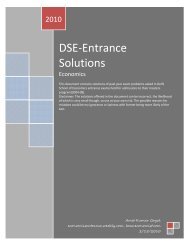

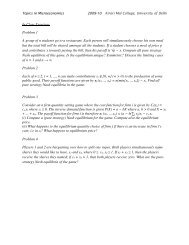

![2. Each of n ≥ 2, i = 1, ..., n can make contributions s i ∈ [0, w] (w ...](https://img.yumpu.com/19311695/1/190x245/2-each-of-n-2-i-1-n-can-make-contributions-s-i-0-w-w-.jpg?quality=85)
